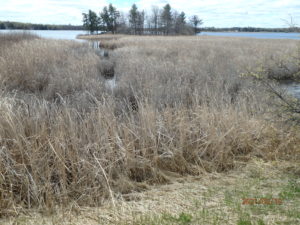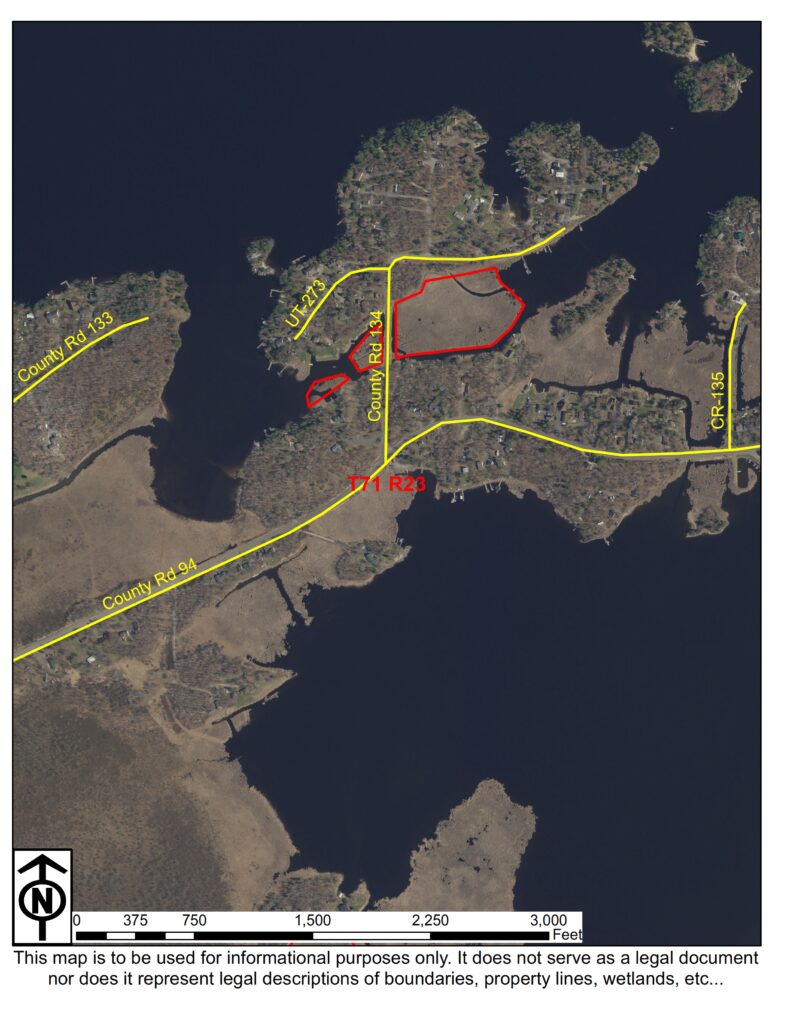 The first objective of the project was the removal of 9 acres of hybrid cattails spanning CR 134 where it crosses Elks Bay that displace native vegetation and wildlife, impact fisheries, impede access to open water, and continue to propagate to other parts of the lake. Employing techniques tested at Voyageurs National Park, this objective was divided into two phases. This first phase would have reduced the biomass using a prescribed burn while ice was still on the lake. The purpose of the burn was to substantially reduce the bulk and cost of subsequent cattail removal. Voyageurs has estimated that burning prior to removal, reduces biomass loads by 6 tons/acre. Unfortunately, due to weather and ice conditions early in 2023, the prescribed burn was not able to be completed.
The first objective of the project was the removal of 9 acres of hybrid cattails spanning CR 134 where it crosses Elks Bay that displace native vegetation and wildlife, impact fisheries, impede access to open water, and continue to propagate to other parts of the lake. Employing techniques tested at Voyageurs National Park, this objective was divided into two phases. This first phase would have reduced the biomass using a prescribed burn while ice was still on the lake. The purpose of the burn was to substantially reduce the bulk and cost of subsequent cattail removal. Voyageurs has estimated that burning prior to removal, reduces biomass loads by 6 tons/acre. Unfortunately, due to weather and ice conditions early in 2023, the prescribed burn was not able to be completed.

The second phase took place the following summer.
After delays due to the historic flood in 2022, long-awaited plans went underway fall 2023.
Lakes Aquatic Weed Removal (LAWR) cut and collected eight acres of the hybrid cattail biomass, completing the portion of the wetland reclamation on the east side of County Road 134. Heavy muck subsurface material made up the bulk of the biomass. LAWR spent 97 hours cutting the biomass and over 670 hours collecting the biomass and disturbed muck that gathered on the water’s surface. Approximately 665 truckloads of cattail biomass, 12 cu. yards per load, were hauled away from the restoration site. Following the site clean-up, rock and sand materials were used to recover the public access, the primary location for biomass piling and removal.
The remaining acre of hybrid cattails on the west side of County Road 134 is planned to be removed in the spring of 2024. Terrestrial seed mix will be planted to recover the area around the public access further. A seed mix of transition species will be planted along the northern edge of the reclaimed wetland. County Road 134 will be raised to incorporate a navigable box culvert, 10 ft x 16 ft in size, to allow for increased water flow and safer road conditions during floods. The road project is estimated to be completed by August 31, 2024. Wild rice will be introduced in the fall of 2024.
Despite the challenges, this stage of the cattail removal appears to have been successful and positive. Landowners’ and partners’ feedback was collected and found to be optimistic about the progress. Support is received for the continuation of removal on the west side of CR 134. Research supports that wild rice is viable at this wetland depth, recovered after hybrid cattail removal. The community looks forward to the next stages and what this project could mean for the future of Rainy Lake and others in our state.
OBJECTIVE PURPOSE:
- Remove trapped nutrients which favor hybrid cattail growth
- Prevent floating cattail mats
- Clear the way for restoration of native habitat

 Photo Credits: Tom Dougherty (August 2023)
Photo Credits: Tom Dougherty (August 2023)

 Photo Credits: Al Meadows (August 2023)
Photo Credits: Al Meadows (August 2023)







